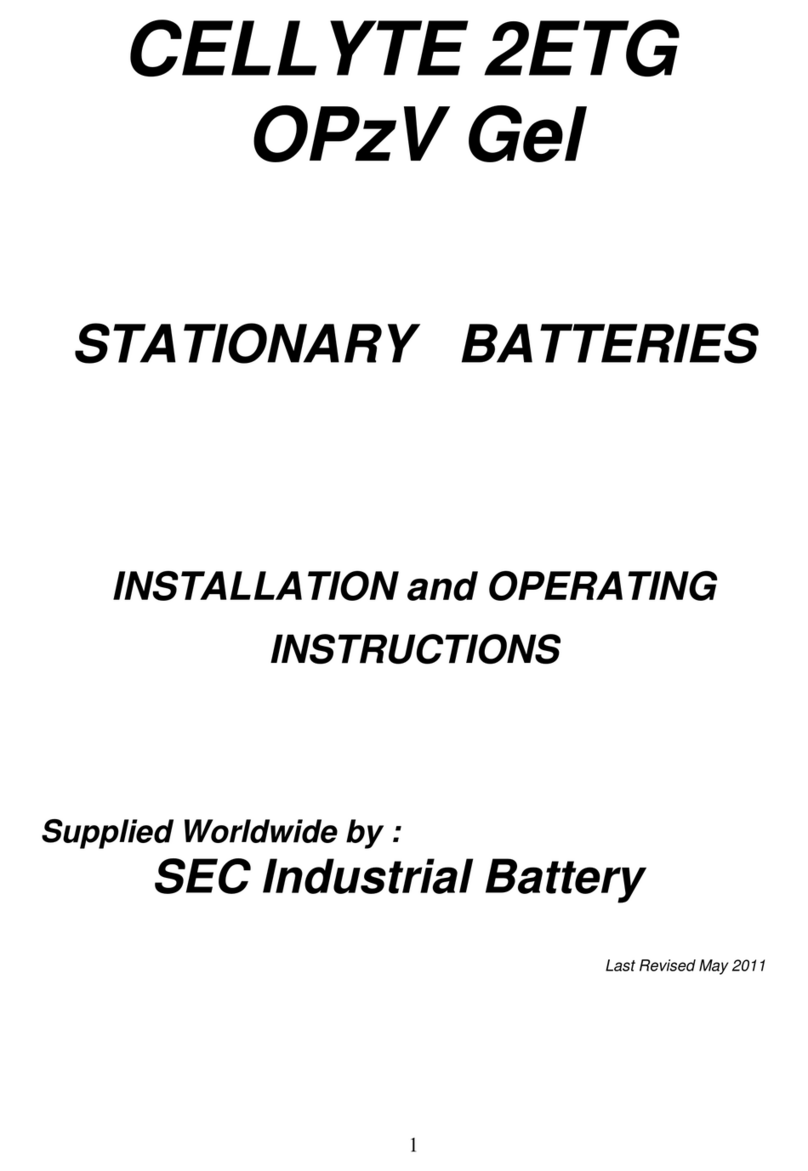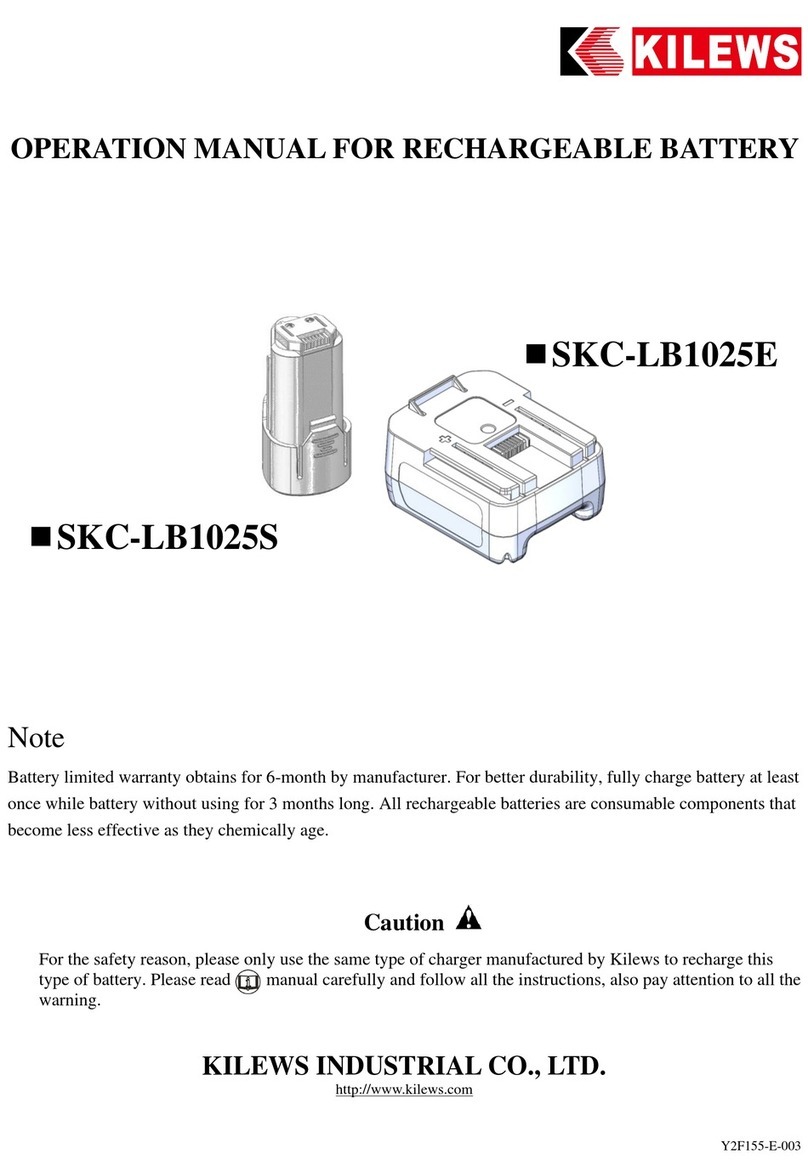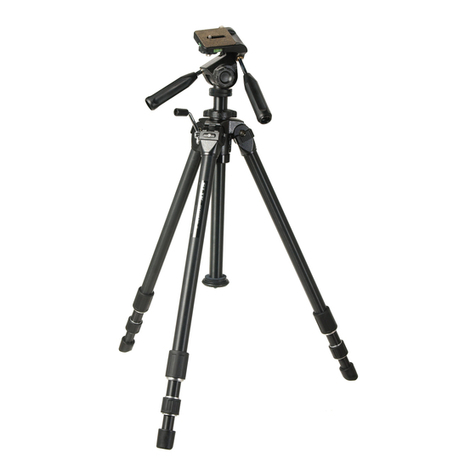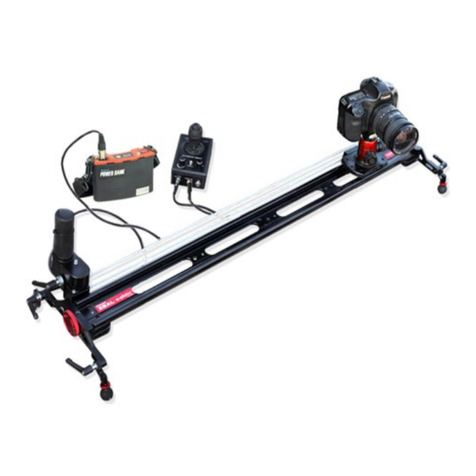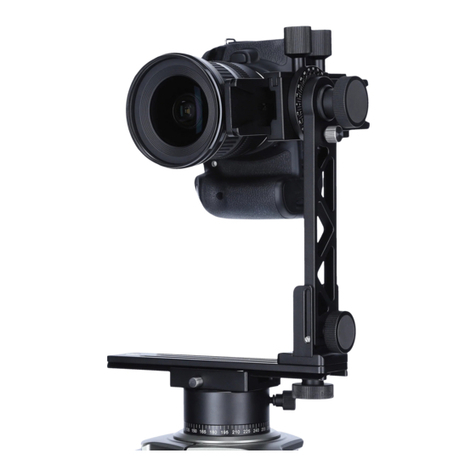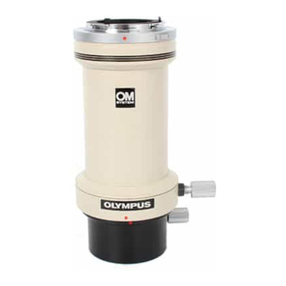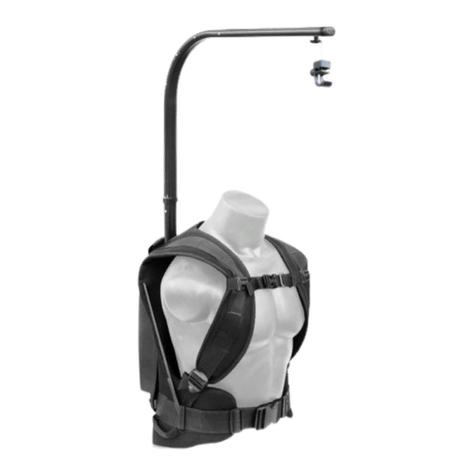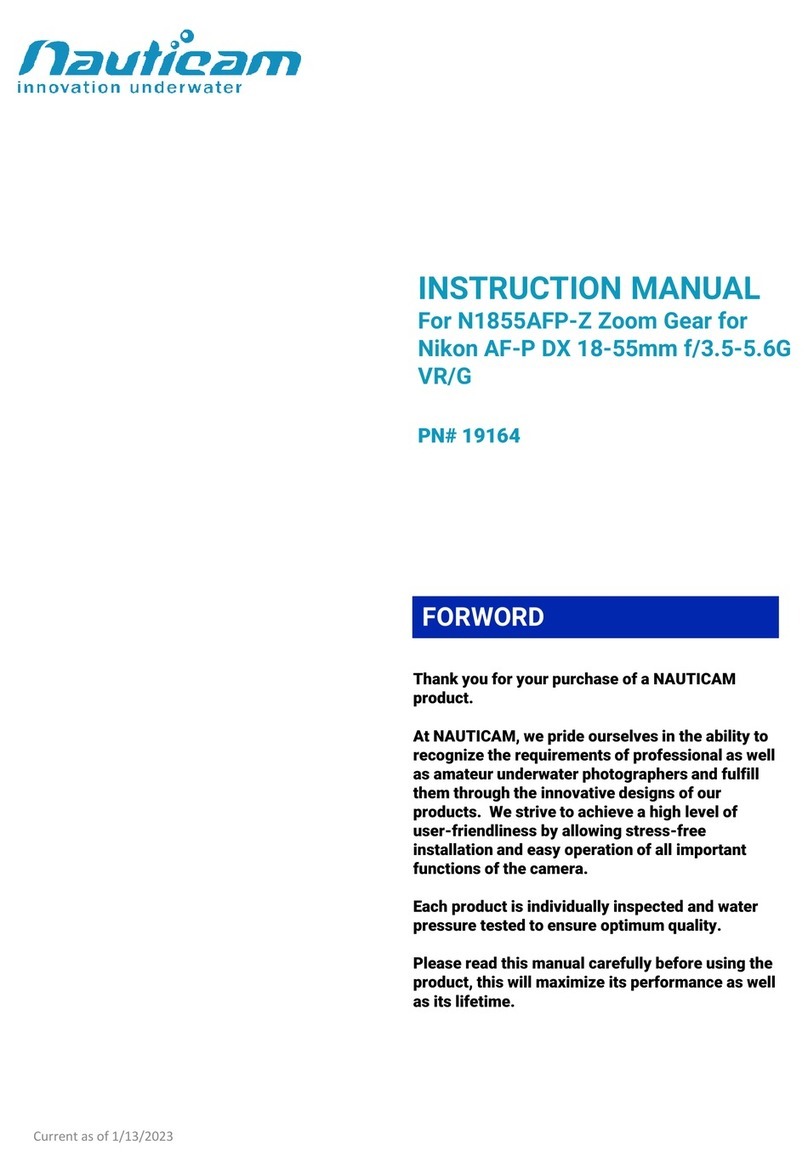SEC CELLYTE 6-12TLA User manual

1
CELLYTE 6-12TLA
STATIONARY AGM BATTERIES
INSTALLATION and OPERATING
INSTRUCTIONS
NON-SPILLABLE by DOT
(Department of Transportation)
ICAO (International Commercial Airline Organization)
and IATA (International Airline Transport Assocaiation)
Supplied Worldwide by :
SEC Industrial Battery Co.
Last Revised May 2011

2
TABLE OF CONTENTS
SECTION CONTENT PAGE SECTION CONTENT
PAGE
1.0 GENERAL INFORMATION 3 5.5 Electrical Connections 5
1.1 Battery Characteristics 3 5.5.1 Cabling recommendations 5
5.5.2 Terminal Preparation 5
5.5.3 Connector Installation 5
2.0 SAFETY INFORMATION 3 5.5.4 Voltage Checks 6
2.1 General Information 3 5.5.5 Battery to Charger Connection 6
2.2 Sulphuric Acid 3 5.5.6 Paralleling of Batteries 6
2.3 Gassing 3
2.4 Electrical Shock 3 6.0 OPERATION 6
6.1 Initial Charge 6
3.0 RECEIPT OF EQUIPMENT 3 6.2 Float Voltage 6
3.1 Delivery Inspection 3 6.2.1 Float Voltage Requirements 6
3.2 Hidden Damage 3 6.2.2 Float Temp. Compensation 6
6.3 Maximum Charge Current 7
4.0 STORAGE 4 6.4 Recharge 7
4.1 General 4 6.5 Equalization Charge 7
4.2 Short Term Storage 4
7.0 STORAGE 7
5.0 INSTALLATION PROCEDURES 4 Long terms
5.1 Battery Location 4
5.1.1 Temperature 4 8.0 MAINTENANCE & RECORDS 7
5.1.2 Temperature Variation 4 8.1 General Maintenance 7
5.1.3 Ventilation 4 8.2 General Records 8
5.1.3.1 Battery Temperature Variation 4 8.2.1 Installation Records 8
5.1.3.2 Ventilation and Gassing 4 8.2.2 Maintenance Records 8
5.1.4 Floor Loading 4
5.2 Seismic Considerations 5 9.0 CAPACITY TESTING 8
5.3 Installation - Cabinets 5 9.1 General 8
5.4 Installation - Racks 5 9.2 Test Procedures 8
5.4.1 Existing racks 5 9.3 Discharge Test Notes 9
5.4.2 New racks 5
5.4.3 Installation 5 10.0 Battery Maintenance Register 10
11.0 Technical Support 11
12.0 Battery Report 12

3
SECTION 1 - GENERAL INFORMATION
1.1 CELLYTE 6-12TLA Battery Characteristics
The CELLYTE 6-12TLA Bloc battery is a valve-
regulated lead-acid recombinant battery designed for
stationary applications. The 6-12TLA battery uses
Absorbed Glass Mat (AGM) technology. This type of
battery has no special ventilation or handling
requirements. Because the electrolyte in the battery is
immobilized, the batteries are considered dry batteries
and can be handled and shipped accordingly.
SECTION 2 - SAFETY INFORMATION
2.1 General Information
Lead acid batteries require care in installation and
maintenance. Unsafe installation or maintenance
procedures can cause severe injury or death. Electrical
shock or burns, acid burns and fire can result if proper
safety precautions are not followed.
The following precautions apply to all battery installation
and maintenance work. For more information, see the
following sections.
- Disconnect all power before attempting to install, remove
or perform maintenance work. When on-charge float
voltages must be measured, be particularly careful
because shorting a battery at this time can cause not
only personal injury, but severe equipment failure as
well.
- Do not tamper with any parts of the battery including
cover, vents, terminal covers, etc.
- Keep batteries clean and dry. Use ½ kg of baking soda
in 4 liter’s of water to neutralize any possible acid. Do
not use cleaners or solvents on any part of the battery.
Do not allow excessive dust to accumulate on the
battery or cabling.
- Keep battery connectors clean, greased and tight. A
loose connection can reduce battery standby time and
cause battery fires.
2.2 Sulphuric Acid
The CELLYTE 6-12TLA Bloc is a lead acid battery and
contains Sulphuric acid in diluted form. Because the
electrolyte is immobilized, in the event of case rupture,
no liquid acid will leak or run from the battery. However,
if the internal components of the battery are touched or
handled, contact with the acid will result.
CAUTION: Sulphuric acid can cause burns and
serious injury if it comes in contact with your skin or
eyes. In the event of contact with Sulphuric acid,
flush thoroughly with water and neutralize any
residual acid with baking soda (1kg in 4 liter’s of
water). Seek medical attention immediately. Do not
handle batteries that have been dropped or where
the container has been ruptured except while
wearing rubber gloves. Do not try to disassemble a
battery.
2.3 Gassing
All lead acid batteries emit some gases during charging
and float operation. Conventional flooded batteries
release all the gases produced to the environment
whereas valve-regulated batteries re-combine most of
the gases internally, releasing very little to the
environment. Compared to a flooded battery of equal
capacity, a CELLYTE 6-12TLA Bloc battery releases a
gas volume of 1% or less than the flooded battery.
Because of this characteristic, no special ventilation is
required under normal usage conditions.
Because some gas is released from lead acid batteries,
never charge or use batteries in an unventilated space
or container. This gas consists of mostly hydrogen gas
and can explode if ignited in a confined area or space.
Keep sparks, flame, or any other ignition source
(including smoking materials) away from batteries.
CAUTION: Hydrogen gas can explode and cause
serious injuries and fire. Do not allow any flame or
ignition source near batteries. Always allow some
ventilation around operating batteries; contact SEC
if there are any questions regarding gassing or
ventilation.
2.4 Electrical Shock
Batteries store large amounts of electrical energy. Even
a discharged battery can deliver a high short circuit
current. Keep all metallic objects away from the battery
terminals. Multi-cell systems can attain lethal voltages.
Remove all jewelry before working on batteries. Cover
all tools with vinyl electrical tape to minimize the
possibility of shorting a battery during installation. Never
lay tools or other metallic objects on batteries. Do not
allow construction work over batteries to proceed unless
the battery is protected by insulating rubber mats.
CAUTION: Shorting a battery can cause serious
injury, fire or explosion. Do not attempt to work on a
battery unless you are familiar with battery
installation procedures and have adequate safety
information and equipment. Read this manual
thoroughly before attempting to install the battery. If
there are any questions about safety, contact SEC
before installing the batteries. SAFETY is always the
primary concern.
SECTION 3 - RECEIPT OF EQUIPMENT
3.1 Delivery Inspection
Immediately upon delivery, inspect the batteries for
damage caused in transit. Damaged pallets or packing
material or disarrayed batteries could indicate rough,
improper handling in transit. Describe in detail (and take
photographs if necessary) any damage on the delivery
receipt before signature. If any damage is found,
contact the carrier immediately, request an inspection,
and file damage claim.
3.2 Hidden Damage
Within 10 days of receipt, inspect all batteries for hidden
damage. Measure and record open circuit voltages
(OCV's). If any damage is found, request an inspection
by the carrier and file a hidden damage claim. Do not
delay this step as it may result in a loss of right of
reimbursement for hidden damages.

4
SECTION 4 - STORAGE
4.1 General
Do not store batteries outside, exposed to the elements.
Store indoors in a cool, dry location. Do not store
batteries in temperatures over 30ºC. The recommended
storage temperature is 20ºC or less. Do not stack pallets
or allow any other material to be stored on top of the
pallets or possible battery damage may occur. Do not
store where the possibility of metallic objects falling on
the battery may occur.
4.2 Short Term Storage
If the batteries are to be stored for 6 months or less at
20ºC, before being put into service, nothing need be
done at this time. If the batteries are to be stored for
longer than 6 months, at temperatures greater than
20ºC, or installation is delayed beyond expected time, a
storage charge may be required. A storage charge is an
equalization charge applied to a battery that is stored in
open circuit (not float charging) condition.
See Section 6.5 for details.
If the storage temperature is 20ºC or less, CELLYTE 6-
12TLA Bloc batteries must be charged at least every 6
months while in storage. For every 8ºC increase above
20ºC, the storage time between charges is cut in half.
Therefore at 28ºC the maximum storage time is 3
months. At 25ºC the maximum storage time would be 4
to 5 months..
Storage of batteries beyond the recommended
temperatures or storage time, without charging, can
result in loss of capacity, cell shorting and loss of float
life. It can also void the battery's warranty. Keep careful
records of battery storage time and handling.
SECTION 5 - GENERAL INSTALLATION PROCEDURES
CAUTION: Before attempting to install CELLYTE 6-
12TLA Bloc batteries study this section and the
section on safety thoroughly. Failure to do so could
result in personal injury and battery or equipment
damage.
5.1 Battery Location
5.1.1 Temperature
Battery location is very important in determining life and
performance of the battery. The ideal environment would
be a dry, indoors, temperature regulated area. The ideal
operational temperature is 20ºC. Operation at
temperatures below this will result in a loss of battery
performance and may result in a larger, more costly
battery being needed. Operation at temperatures above
20ºC will result in loss of battery operation life. For every
8ºC rise in battery temperature above 20 ºC, the life of
the battery will be cut in half. For example, the
CELLYTE 6-12TLA Bloc battery is designed for a 10
year float service life at 20ºC. If the battery were to be
continuously operated at 28ºC, the life expectancy would
be halved.
5.1.2 Temperature Variation
Maintaining temperature balance across the string is
very important for maximum battery life. The difference
between the maximum and minimum block temperature
in a series string can be no more than 3ºC. Excessive
temperature variation will result in the need for
equalization and will shorten battery life.
Sources of battery temperature variation can be
placement of the battery system near a heat source such
as radiators, power equipment, windows or heating
vents. Air conditioning vents can also cause temperature
variations. It is recommended that the battery location
be designed, engineered and monitored to minimize
temperature variations.
5.1.3 Ventilation
Proper ventilation of CELLYTE 6-12TLA Bloc batteries
is important for two reasons :
(1) to minimize battery temperature variations
and
(2) to minimize build up of potentially explosive
hydrogen gas.
5.1.3.1 Ventilation & Battery Temperature Variation
Recombinant batteries such as CELLYTE 6-12TLA Bloc
batteries, give off a small amount of heat during charging
and float operations. Proper ventilation is important to
remove this heat and to prevent temperature differences
from arising in the string. If the batteries are installed in
a cabinet, it should be designed to allow unobstructed air
circulation and prevent temperature build-up. Use angle
iron support rails instead of shelves. If the batteries are
on racks, sufficient air circulation should be present to
prevent temperature-layering effects. In an improperly
designed room, there can easily be a 5ºC difference in
temperature between the floor and the ceiling. If this
difference exists in a series string, it will result in a need
for equalization and in reduced battery life.
5.1.3.2 Ventilation and Gassing
As noted, lead acid batteries emit small amounts of gas
during normal charging and floating. The gas
composition while on float is approximately 80% by
volume hydrogen with the remainder being oxygen.
CAUTION:Hydrogen gas can be explosive. Never
install batteries in an airtight enclosure. Ventilation
must be provided to remove this hydrogen gas.
Allow about 1 litre per hour per battery of air
exchange to prevent hydrogen accumulation.
NOTE: In most cases, the amount of air circulation
required for battery cooling and temperature variation
maintenance will far exceed the amount of air circulation
required to prevent gas build-up. However, ensure some
air exchange is present in the ventilation.
5.1.4 Floor Loading
Before installing the batteries, it should be
ascertained that the floor has the capability to support
the weight of the battery, rack or cabinet and related
equipment. The total system weight will be the sum
of the batteries, rack or cabinet plus 5% for the
battery connectors. It is the responsibilityof the installer
to ensure adequate floor load carrying capabilities.
5.2 Seismic Considerations.

5
CELLYTE 6-12TLA Bloc batteries are capable of with
standing seismic events of UBC Zone 4 magnitude when
properly installed in a suitably designed cabinet or rack.
When seismic capability is desired, suitable floor
anchoring should be provided. Proper floor anchoring is
the responsibility of the installer.
5.3 Installation - Cabinets
When installing CELLYTE 6-12TLA Bloc batteries in
cabinets, follow the recommendations of Section 5.1.3.1
regarding cabinet ventilation. Ensure that the batteries
are electrically insulated from the cabinet frame.
Standard battery spacing is 12 mm minimum between
battery blocks. If the cabinets are to be seismic rated,
the batteries must be firmly strapped or otherwise
attached to the cabinet to prevent battery shifting during
a seismic event. Proper installation is the responsibility
of the installer.
5.4 Installation - Racks.
5.4.1 Existing Racks
When CELLYTE 6-12TLA Bloc batteries are to be
installed on existing racks, ensure that the racks are:
1. of proper size for the intended battery;
2. have sufficient weight carrying capability for the intended
battery, including seismic considerations, and of
sufficient size to hold the number of blocks (plus the 12
mm needed between blocks) for the complete system.
Before the new batteries are installed, touch up any
nicks, scratches or acid marks on the rack with the paint
provided by the manufacturer. Ensure that the rail
insulators are in good condition or replace. Check that
the rack is level and re-level if necessary. Check the
floor anchors and re torque all bolts of the rack to
manufacturer's specifications.
5.4.2 New Racks
Assemble the rack according to the manufacturer's
instructions. Ensure that the rack is level and all bolts
are properly torqued.
5.4.3 Installation
Determine the location of the positive and negative
terminals of the battery with respect to the rack
location. When placing batteries on the rack, alternate
the polarities for proper intercell connection. Standard
spacing between blocks is 12 mm. Gen2TLA&6-12TLAy
position the batteries on the rack. Do not drop.
5.5 Electrical Connections
Proper battery electrical connections are very important
for the best battery performance and utility. Improper
battery connections can cause a loss of standby time or
even a battery fire. Follow the electrical connection
instructions carefully and review Section 2.4 thoroughly
before working on the battery.
CAUTION: Remove all rings and watches before
installing the connectors on the batteries. Ensure
that all tools are insulated with vinyl electrical tape
to prevent shorting. Do not reach or lean across
batteries on step racks. Remember, hazardous
voltages are present. Be aware of what you are
touching at all times.
5.5.1 Battery ratings are specified at the terminals of the
battery. The cabling used to connect the battery
terminals to the load has a voltage drop (when the
battery is discharging) that is dependent on cable length
and conductor size. The longer the cable run, the
greater the voltage drop. The smaller the cable wire
diameter, the greater the voltage drop. Therefore, to get
the best performance from the battery, short, heavy
cables are recommended. Do not size the cables based
on current carrying capacity only. A general rule of
thumb is to allow no more than a 30 mV of voltage drop
per meter of cable run. As an example, if it is 10 meters
from the battery to the load, the cable should be sized to
allow no more than 2 x 10 x .030 = 0.6 volt drop.
Interblock cables are provided, in order to help select
cable sizes for inter-tier and load connections, the
following table should be consulted :
CABLE PROPERTIES AT 20ºC
U.S. CABLE AREA MAX. AMPS
SIZE mm² 30mv DROP/M
8 AWG 8.4 15
6 13.3 23
4 21.2 37
2 33.6 59
1 42.4 74
0 53.5 93
00 67.4 117
000 85.0 148
0000 107.2 187
250 MCM 126.7 221
350 MCM 177.4 309
400 MCM 202.4 353
Use 1.74 amps/mm² for other cable sizes.
5.5.2 Terminal Preparation
Gently clean the contact surface of the terminals with a
brass bristle brush or a Scotch Brite pad. Immediately
after this cleaning, apply a thin layer of No-Ox-Id "A" or
NCP-2 antioxidant grease to the contact areas. A
petroleum jelly such as "Vaseline" may also be used.
5.5.3 Connector Installation
The CELLYTE 6-12TLA Bloc batteries are supplied with
hardware to attach the copper interconnects or cables.
Install the cables (positive of one battery to negative of
the next) and the hardware. Hand tighten only at this
time to allow room for positioning of the blocks. Once all
cables are in place, all connections should be torqued to
the values below :
6-12TLA-15 to 6-12TLA-45 5.1 N-m (45 in pound)
6-12TLA-60 to 6-12TLA 130 7.4 N-m (65 in -pounds)
6-12TLA-150 to 6-12TLA-250 10.2 N-m (90 in.-pounds)
Do not over-torque.
CAUTION: Use extreme care not to short the battery
connections. CELLYTE 6-12TLA Bloc batteries are
capable of very high short circuit currents
containing a very high energy level.
Install the inter-tier cabling at this time, following the
same general instructions as for installing the inter-block
connections. Attach the inter-tier cabling to the wall or
the rack so that the weight of the cable is not on the
battery terminal. If using a stiff cable, pre-bend the cable
so no 'spring' force is placed on the battery terminals.
Failure to support the cable weight could result in a
premature battery failure and loss of battery integrity.

6
5.5.4 Voltage Checks
Visually check that all connections are properly made
(positive to negative) and are tight. Measure the total
string voltage.
CAUTION:High voltage present.
The total string voltage should be approximately 12.5
volts or 6.25 volts for 6 volt, batteries, multiplied by the
number of blocks in the string. If the measured string
voltage is not close to the calculated value, recheck the
battery connections to ensure proper polarity sequence
and measure the individual block voltages. Calculate
the average Bloc voltage and use this value to refigure
the string voltage. If the recalculated and measured
string voltages do not match reasonably well, contact
your SEC representative for further instructions.
5.5.5 Battery to Charger Connection
Ensure that the charger is disconnected from the power
line. If a battery disconnect is installed, open it. The
positive terminal of the battery bank should be
connected to the positive terminal of the charger and the
negative terminal of the battery bank should be
connected to the negative terminal of the charger.
5.5.6 Paralleling of Batteries
When greater battery capacity is desired than what is
available from a single cell or string, paralleling of
batteries becomes necessary.
Batteries must be properly paralleled in order to get the
best system performance and longest battery life. The
battery strings must be treated as equally as possible.
This means equal length cabling to a common collection
point for the load cables, uniform temperature between
the strings and equal strings of batteries. Do not parallel
flooded batteries with valve-regulated batteries as the
charge voltages differ between the types of batteries.
To check the proper paralleling of the strings, connect
the strings in the final form and place a load on the
battery. Measure the load cable voltage drops. The
voltage drops should match within 10%.
SECTION 6 - OPERATION
6.1 Initial Charge
SEC recommends that 6-12TLA batteries be given an
initial charge / equalization charge at the time of
installation in order to ensure that the batteries are fully
charged and the Bloc voltages are uniform. If an initial
charge is not given at the time of installation then block
float voltages may take some months to become
uniform.
The initial or equalize charge voltage for the CELLYTE
6-12TLA Bloc batteries is 2.35 volts per cell at 20ºC.
Calculate the initial charge voltage for your installation
based on either the number of cells in the string or the
number of blocks in the string. Turn on the charger and
raise the charger output voltage (using the equalization
control) to the calculated value. Leave the string
charging at this level for 24 hours. At the end of this
time, reduce the charger output voltage to the float
voltage level. See Section 6.2. Just prior to reducing
the string voltage to the float voltage, measure the block
voltages and charge current if possible.
If the charger output cannot be raised to the calculated
initial charge voltage or the load cannot tolerate a charge
voltage this high, raise the charger output voltage to the
maximum permissible level. Measure the charger output
voltage per cell. Use the following as a guideline:
Max. Voltage Charge Time
Obtained (20ºC) (Hrs.) Min./Max.
2.33 - 2.35 VPC 12 / 24
2.31 - 2.33 VPC 36 / 48
At voltages below 2.29 VPC adequate equalization will
not be obtained. Contact your SEC representative for
additional details on procedures to equalize a battery
under these conditions.
If the ambient temperature is not 20ºC, the initial charge
voltage will have to be temperature compensated (TC).
T C is the process whereby the charge voltage is
changed as the function of the battery temperature. The
temperature correction factor (TCF) for CELLYTE 6-
12TLA Bloc batteries is -0.003 volts / cell / ºC from a
20ºC baseline temperature. As the battery temperature
rises (falls) above (beneath) 20ºC, the charge voltage
must be reduced (raised) the TCF amount for every
degree of change. The formula to calculate the
temperature corrected voltage is :
TCV = CV (20ºC) +/- [T-20 ºC] x (-0.003 v/c)
As an example, if the initial charge were going to be
performed at 32ºC the temperature corrected, reduced,
charge voltage would be :
TCV = 2.35 - (32-20) x (-0.003 v/c) = 2.31 vpc
6.2 Float Voltage
The float voltage is sometimes known as the
continuous charge voltage. It is very important that it
be calculated and set properly for maximum battery
life and performance. The purpose of the float voltage
is to provide enough float voltage and current to the
battery to compensate for the battery self- discharge and
maintain the battery in a fully charged condition of
readiness. Failure to properly follow float voltage
recommendations can result in loss of warranty and
premature battery failure.
6.2.1 Float Voltage Requirement
The recommended float voltage for the CELLYTE 6-
12TLA Bloc batteries is 2.25 volts/cell at 20ºC. +/- 1 ºC.
6.2.2 Float Voltage Temperature Compensation
The float voltage temperature compensation factor is:
0.005 volts per cell per ºC from at 20ºC baseline
(the same as the equalization TCF).
For other temperatures use the following table.
Temperature (ºC) Float Charge V/C
10 2.290
15 2.270
20 Baseline 2.250
25 2.250
30 2.230
35 2.210

7
For temperatures outside of this range see Section 6.1
for the equation used for calculation of the temperature
corrected float voltage.
6.3 Maximum Charge Current
The charge current is normally limited by using the
recommended float voltage. At higher charge voltages
the maximum charge current should be limited to
prevent the possibility of charging the batteries at a
higher rate than they can efficiently accept. Greater than
recommended maximum charge currents can result in
excessive battery heating and gassing and a shortened
battery life.
The maximum charge currents are :
Maximum Charge Rates for CELLYTE 6-12TLA Bloc
TYPE AMPS
6TLA-130 21.1
6TLA-150 23.8
6TLA-200 31.7
6TLA-210 35.2
6TLA-230 37.0
12TLA-15 2.85
12TLA-20 4.01
12TLA-25 4.58
12TLA-35 5.63
12TLA-45 7.39
12TLA-60 9.68
12TLA-70 11.4
12TLA-80 12.3
12TLA-90 14.1
12TLA-100 15.8
12TLA-110 17.6
12TLA-120 19.0
12TLA-130 20.8
12TLA-150 23.3
12TLA-160 25.8
12TLA-175 27.7
12TLA-200 31.4
12TLA-220 34.8
12TLA-250 39.6
6.4 Recharge
Recharge batteries immediately or as soon as possible
after a discharge. Do not wait more than 24 hours to
initiate the recharge after the batteries have been
discharged. Failure to follow this recommendation
could result in a permanent loss of capacity due to plate
sulphation. The approximate recharge time can be
calculated as follows:
AH discharged
------------------------------ x F = charge time Hr.
Available charge current
where F = 3 if the batteries are charged at the float
voltage and F = 2 if an equalization voltage is needed.
Do not exceed the maximum charge currents listed in
Section 6.3.
6.5 Equalization Charge
The equalization charge voltage of the CELLYTE 6-
12TLA Bloc battery is 2.35 vpc at 20°C.. While
equalization is not required under normal operating
conditions, it is possible to operate the battery in such a
way that equalization would be needed. These
conditions would include:
Temperature variation in the string greater than 3ºC
Low float voltage
Low operational temperature without temperature
compensation, Frequent deep discharges
Rapid recharge required
Long delay in recharging the battery after a discharge
Unevenly paralleled string balance
Equalization should be performed on an 'as needed'
basis. The standard equalization would be 24 hours at a
constant voltage of 2.35 VPC at 20ºC. or 2.33 VPC at
25ºC. For equalization at voltages and temperatures
other than the above, see Section 6.1 for methods to
compensate.
Section 7 - STORAGE
When installed CELLYTE 6-12TLA Bloc
batteries will not be used (floated) for a period of time,
the following procedure should be followed:
1. Equalize charge the battery (refer to Section 6.5).
2. Disconnect the battery from all loads. Do not allow any
loads, no matter how small, to remain connected.
3. Equalize charge the battery every 6 months when the
storage temperature is 20ºC or less. For every 8ºC rise
in storage temperature, reduce the storage/equalization
interval by half.
4. Perform an equalization charge on the battery prior to
returning to service. During the storage time, particularly
if it is extended, it is recommended to continue to
monitor and record battery voltage levels. Measure and
record the battery open circuit voltage just before
equalization and then record the on-charge voltage and
current just prior to completing the charge. Refer to
Section 4.0 for more information.
Section 8.0 - MAINTENANCE AND RECORD KEEPING
Maintenance and record keeping is critical to battery life
and warranty continuance. Proper maintenance will
ensure that the batteries are being correctly used and
will be available when needed. Proper record keeping
will ensure that, if there is a problem with a battery, the
customer can demonstrate the batteries were correctly
used and so maintain the warranty.
8.1 General Maintenance
General maintenance of the battery means keeping the
battery and surrounding area clean and dry. Since
CELLYTE 6-12TLA Bloc batteries are of low
maintenance design, there is no addition of water or
specific gravity checks needed for the life of the battery.
The only required maintenance action is an annual
retorque of the battery connections; see Table 1 in
Section 5.5.1 for re torque values. Review Section 2.4
on Electrical Shock before performing this action.
CAUTION: Use only insulated tools.
Do not use any solvents or strong cleaners on or around
the batteries. A dry brush may be used to remove any
dust accumulations. If required, a solution of 1 kg of
baking soda in 4 liters of water may be used as a
multipurpose cleaner if more stubborn stains or dirt
accumulations are present. Follow the rack or cabinet
manufacturer's instructions for maintenance if required.

8
8.2 General Records
8.2.1 Installation Records
When the battery is first received, record:
- Date of receipt,
- Condition of the battery blocs,
- Open circuit voltage of each block,
- Date of installation
- Original P.O. number
- Installer (s)
- Equalization time and voltage
- Any unusual storage conditions.
- Individual block float voltages,
- Ambient temperature,
- Float current,
- Battery temperature,
- String float voltage.
8.2.2 Maintenance Records
Twice per year, record the following :
- Block float voltages
- String voltage
- Float current
- Ambient temperature
- Battery temperature
- Battery conditions
- Any unusual charges or discharges - last 6 months.
Keep the above records in a safe place for review by
maintenance personnel. Remember, these records are
mandatory for any warranty claim on the battery.
SECTION 9 - CAPACITY TESTING
9.1 General
Discharge testing of the battery is performed to
determine the battery capacity. There are two reasons
for performing this test:
(1) A ratings test discharge - the intention here is to
determine the percent of battery capacity as compared
to the rated capacity. This is typically an 8 hour
discharge test.
(2) A service test discharge - this test is to determine the
battery standby time under the actual load conditions of
intended battery usage.
The ratings test discharge is usually performed using a
suitably designed and sized load bank to provide a
constant DC current load to the battery. The test is
performed for the specified period of time to an end-point
voltage per cell (usually 1.67 - 1.80 VPC) with the
ampere hour capacity of the battery calculated by
multiplying the load current by the number of hours of
run time. The actual AH capacity can be compared to
the rated AH capacity to determine percentage capacity.
This type of test is usually used as an acceptance test of
the battery.
The service test is usually performed by placing the
actual load on the battery and determining the actual
time the battery will support the load. This test is done,
in the case of a UPS, by switching into a test mode
where the battery becomes the primary source and the
normal AC line becomes the back-up. If the load is not
critical, the AC input can simply be shut off to simulate a
loss of power event and total system operation can be
verified as well. A load bank can be used if the normal
battery load is well defined.
9.2 Test Procedure
The battery test procedure for either test is :
(1) Ensure the battery is fully charged before capacity
testing and that all connections are clean and tight. If
the battery has not been on float for at least one week,
perform an equalization charge, return the battery to float
charge and allow at least 1 hour to stabilize.
(2) Prepare the load bank or test load system. Ensure all
temporary cable connections are secure and connected
to the proper polarity, and have sufficient current
carrying capacity.
(3) Determine the battery temperature by measuring and
recording the temperature of every 6 blocs. Average
the readings to determine average battery temperature.
Measure the battery temperature in the middle of the
side (preferably) or the end wall of the container.
(4) If a ratings test is being performed, the load current or
power must be temperature corrected if the battery
temperature is significantly different from 20ºC. The
formula for calculating corrected load is :
Temperature corrected load = load at 20ºC x CF,
where CF is the capacity Correction Factor for
temperature.
The following table should be used :
Test Temperature Capacity Correction
(ºC) Factor (CF)
0 0.84
5 0.89
10 0.94
15 0.97
20 1.00
25 1.02
30 1.04
35 1.05
If the service test is being performed, no temperature
correction is necessary.
(5) Just prior to starting the discharge test, measure and
record the individual bloc voltages, the string voltage and
float current (if available).
(6) Remove or disconnect the charger from the battery
string.
(7) Connect the load to the battery and start a timer.
Monitor the string voltage and record the lowest voltage
reached and the time reached (this is called the coup de
fouet and is indicative of a fully charged battery).

9
(8) Record the load current, string and individual cell
voltages on a regular basis. A minimum of three sets of
readings should be taken. The time interval between
sets of readings will vary based on the expected test
time. For example, take readings every hour for the first
4 hours of an 8 hour rating test. For the following 3
hours take readings every ½ hour. For the last hour,
take readings every 15 minutes. For a 15 minute UPS
discharge, readings every 1 to 3 minutes would be
desirable.
(9) Continue the discharge until the string voltage drops
below the end-point voltage per cell times the number of
cells in the string. For example:
1.75 VPC x 60 cells = 105.0 Volts is the stop
discharge.
(10) Stop the timer and remove the load from the battery.
(11) Recharge the battery using the existing charger or an
external charger. An equalize voltage may be used to
reduce charge time.
(12) Record the discharge time and calculate % capacity if a
ratings test was performed.
(13) Keep a copy of all the test data with the battery records.
9.3 Discharge Test Notes:
(1) .CELLYTE Bloc 6-12TLA batteries are shipped at 95%
capacity full capacity will be achieved after a few cycles.
(2) String voltage should be measured at the battery
terminals, not at the load connections.
(3) Accurate meters are essential for correct test results.
Ensure that all meters, shunts, etc., are properly
calibrated before use.
(4) If a long duration test is being performed, the terminal-to-
terminal voltage drop across the intercell connections
should be measured and recorded. This will serve as a
reference for any needed terminal maintenance work
and will assist in verifying the battery integrity.
(5) A float voltage check after the test and recharge is
recommended.

10
SEC BATTERY MAINTENANCE REGISTER
Date Maintenance Description
SEC SEC
Industrial Battery Co. Industrial Battery Co.

11
11 TECHNICAL SUPPORT
SEC is always ready to assist you in your
installation and operation of SEC CELLYTE 6-
12TLA batteries. If you have any questions on
any portion of this manual, please do not
hesitate to call or fax any of our offices listed
below and request assistance.
SEC Industrial Battery Co. Ltd.
Thorney Weir House
Iver, Bucks, SLO 9AQ,
United Kingdom.
Tel.: 44-1895-431543
Fax.: 44-1895-431880
SEC Website: www.secbattery.com
Email:[email protected]
SEC European Sales Office
42 rue de la Rochette
77000 Melum
France.
Tel.: +33 675 590 692
SEC Website: www.secbattery.com
Email: Christian.dhainaut@secbattery.com
SEC Industrial Battery Co. BSC
P.O. Box 32225,
Kingdom of Bahrain
Tel.: 97317-721322
Fax.: 97317-740743
SEC Website: www.secbattery.com
Email: sujo.pulik[email protected]
SEC Industrial Battery Co. Ltd.,
Unit 6, 6F Hewlett Centre,
No.54 Hoi Yuen Road, Kwun Tong
Kowloon, Hong Kong.
Tel.: 852-230 44382
Fax.: 852-230 44013
SEC Website: www.secbattery.com
Email: duncan.low@secbattery.com

12
Installed by:
Operating Company:
Address/Location:
SEC BATTERY REPORT
Representative:
Date: Time:
No. of Cells/String:
No. of Strings/Battery:
Battery Code:
Ambient Temperature:
Battery Information
Battery Charger Information
Type of Battery:
Make
Installation Date:
Model
Battery Charge Current:
Year of manufacture
Charging Equipment:
Type Charging voltage
Current rating
String Float Voltage:
Float Voltage/ Cell:
Float Current:
Cell Temperature:
Float
Charge
Voltage Float
Charge
Voltage Float
Charge
Voltage
Open
Circuit
Voltage Open
Circuit
Voltage Open
Circuit
Voltage
Cell
I.D.
No.
Cell
I.D.
No.
Cell
I.D.
No.
Cell/
bloc
No.
Cell/
bloc
No.
Cell/
bloc
No.
INDIVIDUAL CELL READINGS
1
2
3
4
5
6
7
8
9
10
11
12
13
14
15
16
17
18
19
20
21
22
23
24
25
26
27
28
29
30
31
32
33
34
35
36
37
38
39
40
41
42
43
44
45
46
47
48
49
50
51
52
53
54
55
56
57
58
59
60
61
62
63
64
65
66
Readings Taken By
Readings should be taken at the time of installation and every 6 months thereafter.
Signed:
Remarks and Recommendations:
SEC
Industrial Battery Co. SEC
Industrial Battery Co.
Table of contents
Other SEC Camera Accessories manuals
